
Recently the aging population has become a significant issue in many countries around the world. A report by the Council for Economic Planning and Development (CEPD) indicates the increasing demographic proportion of seniors in countries around the world. In 2010, the total population of seniors in Taiwan has exceeded 10% among the whole population. And it is estimated its proportion will exceed 35% by the year 2050, ranking the second oldest society in the world and will be only preceded by Japan. It is commonly known that Europe has the most aged population; however, it took 125 years for the rate of which to climb from 7% to 14% in France, 80 years in Sweden, and 65 years in the U.S. But it only takes 24 years for Taiwan to become an aged society. In other words, one out of every four or five individuals is a senior in the 21st century, marking Taiwan as an aged society soon.
According to the UN World Population Prospects, the growth rate of the 64-year-old-and-above group will be the highest compared to that of the 15-and-above and 15-to-64 before year 2050, and the growth rate is remarkably rapid in the industrialized nations. The pension-collecting senior population will dominate the world in the future, especially in advanced nations such as the U.S., several European countries, and Japan in Asia. The reason is that the growth rate of pension collectors will be higher in these industrialized nations than the rest of the world, naming them the primary "caregivers of seniors." In addition, an analysis by the Sporting Goods Manufacturers Association (SGMA) on the future of the sporting goods industry in the U.S. indicates that as the baby boomers age, the population of those who are 45 years or older and the demand of sporting equipment will continue to increase. Further, a statistics given by the American Sports Data indicates two significant patterns in the American fitness market in the past decade: 1. the drastic increase of the number of fitness club members, and 2. the significant increase of mid/old-aged individuals engaging in fitness activities. With the constant development of new products by American fitness equipment providers in the past two years, the rate of the public's fitness participation has increased as a result.
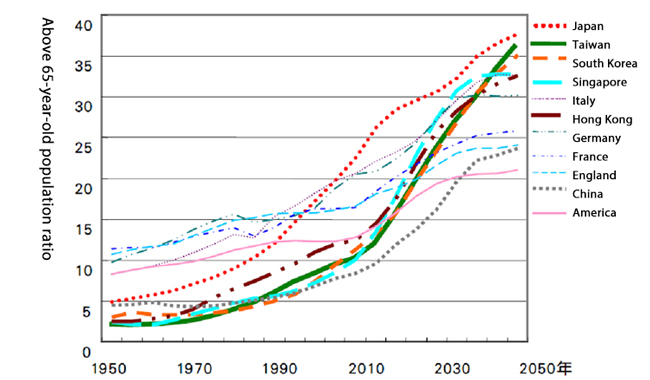
Source: 2008 Demographic Prospects by CEPD (estimated values for year 2008~2050)
Trends in the Senior Fitness Market
The aging population in the developed nations has imposed widespread impacts on the global economy, technology, and medicine. In all, the baby-booming generation takes up 58% of the entire global labor market, and their retirement in the next 5 to 10 years poses as a great challenge to the world. However, this might be promising market targets in the business sectors of food, clothing, housing, transportation, education, entertainment, medical services, and insurance services, etc. They could cater to the aging population by re-position and reform market products.
The aging population shares one common wish: how to slow down the aging process. Health-related products for seniors will become the major competitive global market in the near future. In terms of product-design, household and mobile health-care products covering physiological/psychological monitoring and interactive entertainment provide seniors with personal care. These are all potential new markets.
Analysis of Senior Fitness Products
In the aging society, there will be new demands for seniors such as appropriate sporting and rehabilitation equipments. The bone density in mid/old-age individuals who are 55 or above weakens every year and worsens if they do not get enough exercise. About 25% of them engage in fitness activities, which is a four-fold growth compared to two decades ago. At the moment, the reasons why mid/old-age individuals are more engaged in fitness activities than other age groups include having more time to exercise and for the sake of health; more importantly, they are being highly recommended by doctors, medical professionals, and fitness trainers. They push the said aging group to exercise regularly. Due to physical considerations and declined coordination and balancing, seniors should avoid fierce exercises. Of the fitness activities, it is more ideal for them to utilize fitness equipment or low-impact activities.
Currently, the more popular senior fitness products aim at improving muscle performance, flexibility, endurance, circulation, cardiovascular performance, and balancing. At present, the major design of the training fitness products for seniors is for home-use. The reason is that the equipment in most gyms focuses on younger people. They may overburden and injure seniors once they do not use the equipment inappropriately. Therefore, the sports equipment selected is specially designed for seniors; for example the treadmill features an ultra-low platform, low-speed rotation, handrails on both sides with soft cushions. Senior communities, caring homes, and households in Europe, the U.S., and Japan all have basic, effective fitness instruments, and the special and innovative ones are as follows.
(1) Multi-purpose Fitness Chair
Being the most popular equipment in the market, this chair is easy to use, compact, safe, and durable. It allows one to engage in health-maintaining, fundamental exercises by starting with low-torque drills and gradually increase the intensity and resistance. Details of the product are as follows:
1. Basic moves

(1. Training Biceps /2. Shoulders and Chests Exercise /3. Ladder Stepping Exercise /4. Aerobic Exercise /5. Abdominal Muscle Exercise)
Multi-purpose Fitness Chair
from: http://tw.myblog.yahoo.com/jw!Nbw_zpeXCkFJT18ebNc-/article?mid=224
Description: The design of the chair and the retractable handles allows the user to engage in effective training under different postures and greatly improves cardiovascular capacity. The lighter stepping exercise also reduces stress on the knees and ensures safety.
2.Additional features
Multi-purpose Fitness Chair
from: http://tw.myblog.yahoo.com/jw!Nbw_zpeXCkFJT18ebNc-/article?mid=224
Description: The cycling wheel can be installed to target at the hip and legs. The level of resistance can be adjusted to satisfy different fitness objectives. |
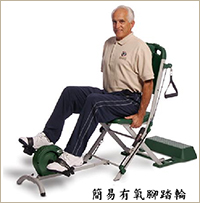 |
3. Foldable
Multi-purpose Fitness Chair
from: http://tw.myblog.yahoo.com/jw!Nbw_zpeXCkFJT18ebNc-/article?mid=224
Description: The light-weight material and design allows the unit to be folded and stowed away easily. |
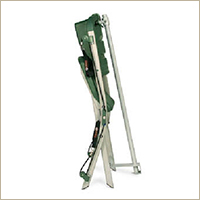 |
(2) Wave-shaped Tactile Trail
A major consideration is for seniors to improve their balancing and suppress regression, and this is why the Wave-shaped Tactile Trail is also a popular item. Details of the product are as follows:
1. The protruding grains gently massage the bottom of the feet and stimulate the nervous system.
2. The gentle up and down hills help one improve the sense of balance. |
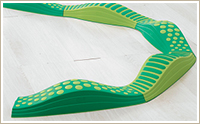 |
Wave-shaped Tactile Trail
from: http://www.ez66.com.tw/T5004ShowCmdyData?&y_SketchName=Sketch1-2_Hi178&y_KindId=942664&y_HrefId=&y_CompId=216&&y_MuId=
The above products available on the market indicate the fitness equipment for seniors has simple designs and ensures health benefits. However, the simple movements lack fun after being repeated extensively.
Primary needs and markets of future fitness products for seniors
At the moment, the most common recreational activities that seniors engage in are static, including watching TV, listening to the radio, taking a walk, singing, or playing chess or card games. These entertainment and recreations take up a heavy proportion in seniors' daily routine. These activities are mainly influenced by one's financial status, past occupation, education, and life experiences. Today's seniors have a lower level of acceptance of the latest high-tech products or participation in digital recreational activities. With increased level of education, income, and computer literacy, future seniors enjoy more diverse combinations of recreational activities and fitness equipment.
The design of fitness equipment for future seniors needs to be friendlier by combining fitness, entertainment, and MEMS systems for the purpose of facilitating fitness and rehabilitation. Micro-Electro-Mechanical Systems, or MEMS, has a wide array of applications in domains such as blood-pressure monitoring, heart-rate monitoring, inhalers and breathers, lung capacity meters and respiration treatment equipment, and eye-pressure monitoring. Further, the technology of interactive platform and image recognition is utilized to allow interactions between the user and the machine. However, for seniors under rehabilitation, they need to work on muscle endurance and dexterity, and a rehabilitation program based on the man-machine interaction that combines RS232 transmission and virtual reality provides seniors with diverse 3D games that make the session more fun and allow doctors to keep track of the effectiveness of the treatment through real-time video conferencing.
In terms of limbic movements, IMU (Inertial Measurement Unit) is utilized, and the accelerometer and gyroscopes will become the key components in such applications. IMU utilizes the Tri-Axis Accelerometer to monitor the human posture and sends the data of limbic movements wirelessly to the fitness equipment, personal computer, or mobile phone. This allows the user to keep track of one's physical data or to send the information to doctors or fitness trainers who may determine whether the work load is within the safe range.
It is estimated the market value of IMU would exceed 1.9 billion USD in 2012, with vast applications and business opportunities in motion-sensing gaming machines or handheld devices, man-machine interface, and fitness and rehabilitation monitoring.
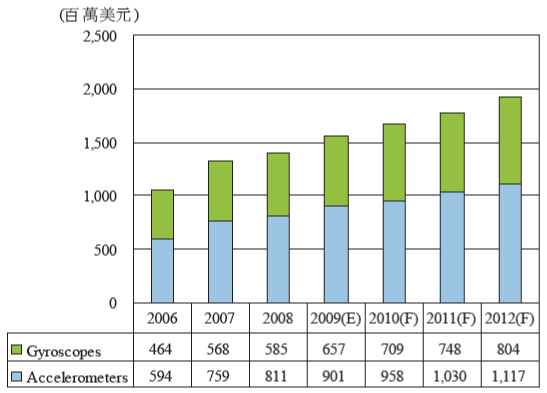
Scale of market development of IMU from 2006~2012; from: Topology Research Institute
| Application of IMU |
Product development |
| Sporting equipment for children |
Hand-foot-eye coordination sporting goods, equipment for toddlers, brain-developing equipment. |
| Sporting equipment for seniors |
Equipment for balance-training, flexibility, and memory-enhancement. |
| Sports information communication technology |
Equipment for detecting bio-signals during exercise, sport-related wireless/remote transmission equipment, and cloud-computing virtual fitness trainer system. |
| Equipment for stress-relieving, entertainment, or rehabilitation. |
Sporting equipment for flexibility, cardiovascular training, core muscle training, and rehabilitation. |
Direction of the application, utilization, and development of IMU; from: Topology Research Institute
The aging population has become a global issue. As seniors' muscle and balancing performance deteriorate over time, a key task in the future is how to help seniors slow down the aging process and improve their quality of life and physical fitness. Research indicates fitness training improves seniors' muscle performance, lower-body muscular and neurological coordination, and balancing; the improvements in turn enhance seniors' gait and motion, reduce the factors that lead to falls or fractures, and slow down the aging process. The future direction of fitness products' R&D is summarized below:
- It is necessary to get rid of the boredom of traditional fitness equipment. And more importantly, to develop low-workload fitness equipment shall be the major point.
- By introduce multimedia systems and gaming products, and use the interactive interface, encourage senior to exercise and have fun at the same time. Motion-sensing games help seniors to stay active, improve cardiovascular performance, enhance health, and stimulate the brain, ensuring rehabilitative effects on deteriorating functions.
- Introduce "virtual trainers" that help users use the equipment properly through the training mode and avoid injuries.
- Use MEMS to monitor the user's physical condition. This not only reduces cost but also allows doctors and users to use the data as reference. The utilization of MEMS will thus become a major task in the future.
Conclusion
The technological integration of MEMS is the future of fitness equipment. Interactive games allow seniors to train and stimulate their minds, and put more fun in fitness and medical rehabilitation. The recently popular and profitable games that combine recreation and fitness have turned exercising into fun challenges through advanced technology. Surely they shall be perfect for seniors and will gain more popularity in the near future.
Primary future objectives are to integrate fitness equipment for seniors, including the design of equipment, application of gaming software, and the integration of MEMS and IMU. Whether used in hospitals, senior homes, and individual households, the demand and the popularity of such products will continue to rise and foremost, they will improve the health of seniors.
References
- 2008 Demographic Prospects by CEPD
- "A discussion on the future of the fitness equipment industry by examining the global age structure" by the Footwear and Recreation Technology Research Institute.
- Ez66 http://www.ez66.com.tw
- Cycling & Health Industry R&D Center http://tbis.tbnet.org.tw/chc-health/chchealth-01.html
- "A discussion on the rationality, trend, and business opportunity of recreational electronic games for seniors in Taiwan." Department of Digital Media Design, Hwa Hsia Institute of Technology.
- The next critical component: IMU (Inertial Measurement Unit) Topology Research Institute
- A discussion on the business opportunities in the integration of information technology and health management. Yi-ching Huang.
- Prospects of the business opportunities in seniors-related industries. Ke-chin Li.
- "Billions worth of business opportunities in the care-giving industry for seniors" by Hui-rong Tu, Commercial Times.
- EHVA Newsletter v. (23).
|